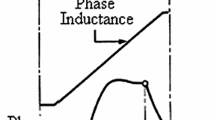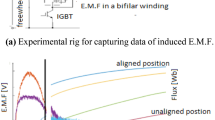Abstract
Switched reluctance motor (SRM) is becoming popular due to its simple construction, low manufacturing cost, ruggedness and fault-tolerant capability. In conventional switched reluctance motor (SRM), rotor is laminated. But in solid rotor switched reluctance motor (SRM), rotor is not laminated, and it is suitable for applications where rotors are immersed in water environment. A stationary can arrangement is introduced between stator and rotor. In this research, an 8/6 solid rotor switched reluctance motor which is used in reactivity control mechanisms of nuclear reactors is considered as test motor. As solid rotor switched reluctance motor is suitable for working in water environments in nuclear reactors, rotor position estimation is the topic of interest. A new approach which adopts two-phase excitation method is presented for rotor position estimation. Four different artificial neural networks (ANNs) with 2-5-5-1 structure are trained to estimate rotor position. The main advantage of this approach is to minimize the required number of voltage and current sensors. The validity of the new approach is verified through online comparison of estimated and actual rotor position.






Similar content being viewed by others
References
Miller TJE (1987) Brushless Reluctance Motor Drives. IEE Power Eng J 1:325–331
Miller TJE, McGilp M (1990) Nonlinear theory of the switched reluctance motor for rapid computer aided design. IEE Proc 137(6):337–347
Ye ZZ, Martin TW, Balda JC (2000) An investigation of multiphase excitation modes of a 10/8 switched reluctance motor with short flux path to maximize its average torque. International Symposium on Industrial Electronics, Cholula, Puebla, Mexico, pp 390–395
Farshad M, Faiz J, Lucas C (2005) Development of analytical models of switched reluctance motor in two-phase excitation mode: extended miller model. IEEE Trans Magn 41(6):2145–2155
Jain AK, Mohan N (2006) Dynamic modeling, experimental characterization and verification for SRM operation with simultaneous two-phase excitation. IEEE Trans Ind Electron 53(4):1238–1249
Abraham A (2001) Neuro-fuzzy systems: state-of-the-art modelling techniques. Proceedings of the sixth international work conference on artificial and natural neural networks, connectionist models of neurons, learning processes and artificial intelligence-part I, pp 269–276
Cheok AD (2005) Fuzzy logic rotor position estimation based switched reluctance motor DSP drive with accuracy enhancement. IEEE Trans Power Electron 20(4):908–921
Cheok AD, Ertugrul N (2000) High robustness and reliability of fuzzy logic based position estimation for sensorless switched reluctance motor drives. IEEE Trans Power Electron 15(2):319–334
Mese E, Torrey DA (2002) An approach for sensorless position estimation for switched reluctance motors using artificial neural networks. IEEE Trans Power Electron 17(1):66–75
Lachman T, Mohamad TR, Teo SP (2003) Sensorless position estimation of switched reluctance motors using artificial neural networks. IEEE Int Conf Robot Intell Syst Signal Process 1(8–13):220–225
Enayati B, Saghaiannejad SM (2006) Sensorless position control of switched reluctance motors based on artificial neural networks. IEEE Int Symp Ind Electron, pp 2266–2271
Paramasivam S, Vijayan S, Vasudevan M, Arumugam R, Krishnan R (2007) Real-time verification of AI based rotor position estimation techniques for a 6/4 pole switched reluctance motor drive. IEEE Trans Magn 43(7):3209–3222
Hudson CA, Lobo NS, Krishnan R (2008) Sensorless control of single switch based switched reluctance motor drive using neural network. IEEE Trans Ind Electron 55(1):321–329
Acknowledgments
The support of management and staff members of Thiagarajar College of Engineering for this research work is greatly acknowledged. The research project is supported by Board of Research in Nuclear Sciences (BRNS), Department of Atomic Energy (DAE), India.
Author information
Authors and Affiliations
Corresponding author
Rights and permissions
About this article
Cite this article
Jessi Sahaya Shanthi, L., Arumugam, R. & Taly, Y.K. A novel rotor position estimation approach for an 8/6 solid rotor switched reluctance motor. Neural Comput & Applic 21, 461–468 (2012). https://doi.org/10.1007/s00521-010-0447-8
Received:
Accepted:
Published:
Issue Date:
DOI: https://doi.org/10.1007/s00521-010-0447-8




